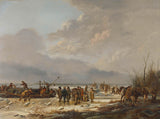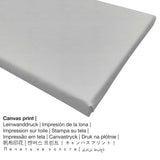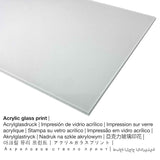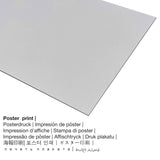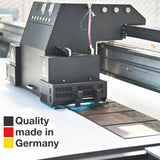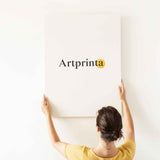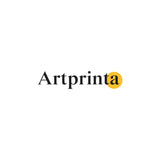Pieter Gerardus van Os, 1814 - Na-agbaji ice na Karnemelksloot, Naarden, Jenụwarị - mbipụta nka mara mma.
Ụtụ gụnyere. Mbupu gbakọrọ na ndenye ọpụpụ.
"Breaking the Ice on the Karnemelksloot, Naarden, January" from the Dutch painter Pieter Gerardus van Os as your personal artprint
The nkà nke oge a work of art was painted by the Dutch painter Pieter Gerardus van Os in 1814. Taa, mpempe nka a bụ nke mkpokọta nka dijitalụ nke Rijksmuseum. Site n'ikike nke Rijksmuseum (nwere ikike: ngalaba ọha).Na mgbakwunye na nke ahụ, artpiece nwere creditline:. E wezụga nke ahụ, nhazi nke mmepụta dijitalụ dị n'ime odida obodo format n'akụkụ akụkụ nke 4: 3, nke pụtara na ogologo bụ 33% ogologo karịa obosara. Pieter Gerardus van Os was a male engraver, painter, drawer, whose artistic style was primarily Realism. The European artist was born in the year 1776 na Hague, The, South Holland, Netherlands ma nwụọ mgbe ọ dị afọ 63 na 1839.
Ozi izugbe si Rijksmuseum webụsaịtị (© Nwebiisinka - site Rijksmuseum - www.rijksmuseum.nl)
The doorijzen the Karnemelksloot in Naarden January 1814. Horses pulling a barge through the ditch frozen. On the boat and on the ice are men with hammers and axes to smash the ice. In the distance the profile of Naarden.
Iberibe nkọwa nka
| Aha nka nka: | "Breaking the Ice on the Karnemelksloot, Naarden, January" |
| Nhazi: | sere |
| Okwu nche anwụ: | nkà nke oge a |
| oge: | 19th narị afọ |
| Afọ okike: | 1814 |
| Ogologo afọ nka nka: | karịa afọ 200 |
| Ụlọ ihe ngosi nka / mkpokọta: | Rijksmuseum |
| Ebe ebe ngosi nka: | Amsterdam, Netherlands |
| E Nwere na: | Rijksmuseum |
| Ikikere nke ihe osise: | ngalaba ọha |
| Site n'aka: | Rijksmuseum |
metadata omenka ahaziri ahazi
| aha: | Pieter Gerardus van Os |
| A makwaara dịka: | pieter geraldus van os, Os, P. G. van Os, P G van Os, Os Pieter Gerardus van, Pieter Gerardus van Os, P. G. v. Os, pieter gerhard van os, P.G. van Os, Os van Pieter Gerardus, Os Pieter Geradus van |
| okike nke onye nka: | nwoke |
| Obodo onye nka: | Dutch |
| Ọrụ nke onye na-ese ihe: | ihe osise, eserese, drawer |
| Obodo obibi: | mba netherland |
| Nhazi nke onye nka: | omenkà nke oge a |
| styles: | Ihe ngosi |
| Oge ndu: | 63 afọ |
| A mụrụ: | 1776 |
| Amụrụ na (ebe): | Hague, The, South Holland, Netherlands |
| Afọ ọnwụ: | 1839 |
| Nwuru na (ebe): | Hague, The, South Holland, Netherlands |
Họrọ ngwa ngwaahịa gị
Anyị na-enye ụdị dị iche iche nha na ihe maka ngwaahịa ọ bụla. Ị nwere ike ịhọrọ n'ime nhọrọ nhazi ngwaahịa ndị a:
- Kwaaji: A printed canvas stretched on a wood stretcher frame. Further, a canvas print produces a cosy, positive look. How can I hang a canvas print on my wall? The advantage of canvas prints is that they are relatively low in weight, meaning that it is easy and straightforward to hang up the Canvas print without any wall-mounts. Therefore, a canvas print is suited for any kind of wall.
- Mbipụta nke aluminom: This is a metal print made on aluminium dibond with an impressive depth. A direct Direct Print on Aluminum Dibond is your excellent introduction to art replicas produced with aluminum. For the Aluminium Dibond option, we print your artpiece right onto the surface of the white-primed aluminum. The bright & white sections of the original artpiece shine with a silk gloss, however without any glare.
- Mbipụta enyo acrylic: The print on acrylic glass, which is often labelled as a print on plexiglass, transforms your favorite original work of art into décor. The artwork will be custom-made with the help of state-of-the-art UV print technology. This creates the image effect of sharp, vibrant colors.
- Mpempe akwụkwọ (ihe kwaaji): The poster print is a UV printed sheet of cotton canvas paper with a granular surface texture, that reminds the original artwork. A poster print is best suited for framing your art print with the help of a personal frame. Please bear in mind, that depending on the absolute size of the poster print we add a white margin between 2-6cm around the work of art, which facilitates the framing with a custom frame.
Ozi ngwaahịa ahaziri
| Ụdị ngwaahịa: | ọrụ mgbidi |
| Usoro mmeghari: | dijitalụ mmeputakwa |
| Production usoro: | Mbipụta UV ozugbo |
| Ihe ngosi: | German mmepụta |
| Ụdị ngwaahịa: | na mmepụta ihe |
| Ngwaahịa were: | Ụlọ ihe ngosi nka, ụlọ mmepụta ihe nka |
| Ndepụta: | usoro odida obodo |
| Njikwa oyiyi: | (ogologo: obosara) 4: 3 |
| Ntụgharị nkọwa akụkụ onyonyo: | ogologo bụ 33% ogologo karịa obosara |
| Akwa mmeputakwa dị: | Mpempe iko acrylic (nke nwere ezigbo mkpuchi iko), mbipụta ọla (aluminium dibond), mbipụta akwụkwọ mmado (akwụkwọ kwaaji), mbipụta kwaaji. |
| Mbipụta kanvas (akwa akwa n'elu etiti ihe ndọtị) ụdị nha dị iche iche: | 40x30cm - 16x12", 80x60cm - 31x24", 120x90cm - 47x35", 160x120cm - 63x47" |
| Mpempe iko acrylic (nwere ezigbo mkpuchi iko) nha: | 40x30cm - 16x12", 80x60cm - 31x24", 120x90cm - 47x35", 160x120cm - 63x47" |
| Mpempe akwụkwọ mmado (akwụkwọ kwaaji) nha: | 40x30cm - 16x12", 80x60cm - 31x24", 120x90cm - 47x35" |
| Nhọrọ nha nke mbipụta aluminom (aluminium dibond material) | 40x30cm - 16x12", 80x60cm - 31x24", 120x90cm - 47x35" |
| Igwe onyonyo: | mmeputakwa na-enweghị isi |
Nkwupụta iwu: We try everything in order to describe our products as accurate as possible and to exhibit them visually. Please bear in mind that the pigments of the print products and the imprint may vary to a certain extent from the presentation on the device's monitor. Depending on your screen settings and the nature of the surface, not all color pigments are printed as exactly as the digital version depicted here. Since all our are printed and processed manually, there may also be minor deviations in the exact position and the size of the motif.
© Copyright - Artprinta.com

